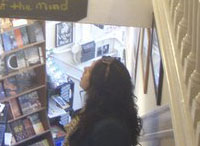
In the FYC Classroom
Classroom Starting Points
To introduce students to spontaneous composing, I assign Kerouac’s (2003a) “Essentials” and ask students to bring a photo with them to class. Together, we discuss the tenets of his method. I ask them questions like “What’s the jewel center of interest” (Kerouac’s phrase for the focal point of the writing) and “What does Kerouac seem to suggest about the restraints placed upon writers?” I am particularly interested in how they see his style diverging from the writing they’ve learned in the past. After discussing the parameters of spontaneous composing, I guide students through a series of writing activities. First, I have them use the photo they brought with them to class as their “jewel center of interest”—they then write without pause for about ten minutes. Their main objective is to write freely but trying to capture as much detail as they can. Afterward, I take them through the process again, only the second time, I’ll play a jazz CD—Charlie Parker, perhaps. I try to get students to think about the differences between composing to music versus in silence, encouraging them to think about the ways in which sound affects the composing process. This also prompts students to anticipate how ambient sounds might affect them as they are composing in the field. At the end of this lesson, I pass out the assignment sheet for the spontaneous composing log. The beginning of the next class period focuses on medium and the materialities of composing; during this period I push students to think about a choice of medium for their logs.
Once students have become accustomed to keeping their logs, I assign a partnered observation, where students introduce a peer to one of their habitual sites. Individual students compose two log entries for this assignment, one for each site. After the observations, students discuss their observations, taking note of the similarities and differences. Students write a 2-3 page report of their findings that considers what factors that might have accounted for any differences in perspectives and how the experience might inform future log entries. The goal here is for students to learn the subjective dimensions of observations and field work and the partiality of perspective we bring to any observation, to teach them that “a way of seeing is also a way of not seeing” (Burke, 1935, p. 49).
I frame the first part of the course with readings and texts that deal with place, space, and/or visual representation. Readings on field research and personal writing would also be useful for students, especially when they are first introduced to the spontaneous log. In addition, whole-class tours to on-campus sites work especially well under this model.
Example Texts: Jamaica Kincaid (1991), “On Seeing England for the First Time”; Brent Staples (1998) “Just Walk On By: A Black Man Ponders His Ability to Alter Public Space”; Gloria Anzaldúa (1999) excerpts from Borderlands/La frontera; Jack Kerouac (2003b), excerpts from On the Road; Spike Lee (2006), When the Levees Broke.